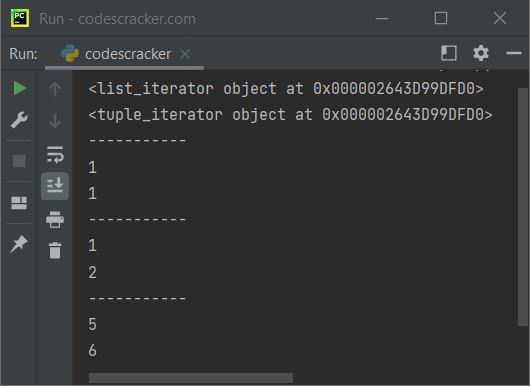- Python Built-in Functions
- Python All Built-in Functions
- Python print() Function
- Python input() Function
- Python int() Function
- Python float() Function
- Python len() Function
- Python range() Function
- Python str() Function
- Python ord() Function
- Python chr() Function
- Python ascii() Function
- Python pow() Function
- Python type() Function
- Python List Functions
- Python list() Function
- Python insert() Function
- Python append() Function
- Python extend() Function
- Python pop() Function
- Python remove() Function
- Python reverse() Function
- Python sort() Function
- Python sorted() Function
- Python Dictionary Functions
- Python dict() Function
- Python update() Function
- Python get() Function
- Python keys() Function
- Python setdefault() Function
- Python fromkeys() Function
- Python items() Function
- Python popitem() Function
- Python Tuple Function
- Python tuple() Function
- Python Set Functions
- Python set() Function
- Python frozenset() Function
- Python String Functions
- Python split() Function
- Python join() Function
- Python format() Function
- Python replace() Function
- Python Iterator Functions
- Python iter() Function
- Python min() Function
- Python max() Function
- Python sum() Function
- Python count() Function
- Python index() Function
- Python copy() Function
- Python clear() Function
- Python next() Function
- Python filter() Function
- Python enumerate() Function
- Python zip() Function
- Python reversed() Function
- Python Number Functions
- Python abs() Function
- Python bin() Function
- Python oct() Function
- Python hex() Function
- Python round() Function
- Python divmod() Function
- Python complex() Function
- Python File Handling Functions
- Python open() Function
- Python read() Function
- Python readable() Function
- Python readline() Function
- Python readlines() Function
- Python write() Function
- Python writable() Function
- Python writelines() Function
- Python close() Function
- Python seek() Function
- Python tell() Function
- Python flush() Function
- Python fileno() Function
- Python truncate() Function
- Python Class Functions
- Python object() Function
- Python property() Function
- Python getattr() Function
- Python setattr() Function
- Python hasattr() Function
- Python delattr() Function
- Python classmethod() Function
- Python staticmethod() Function
- Python issubclass() Function
- Python super() Function
- Python Misc Functions
- Python all() Function
- Python any() Function
- Python isatty() Function
- Python bool() Function
- Python callable() Function
- Python globals() Function
- Python locals() Function
- Python dir() Function
- Python id() Function
- Python isinstance() Function
- Python map() Function
- Python repr() Function
- Python slice() Function
- Python vars() Function
- Python Advance Functions
- Python help() Function
- Python hash() Function
- Python breakpoint() Function
- Python bytes() Function
- Python bytearray() Function
- Python memoryview() Function
- Python compile() Function
- Python eval() Function
- Python exec() Function
- Python Tutorial
- Python Tutorial
- Python Examples
- Python Examples
Python iter() Function
The iter() function in Python returns an iterator object. An iterator object allows to traverse a container, like a list or a tuple etc. For example:
x = iter(["01", "Wed", "Dec", "2021"]) print(next(x)) print(next(x)) print(next(x)) print(next(x))
The output will be:
01 Wed Dec 2021
Note: The next() function returns the next item of an iterator.
Python iter() Function Syntax
The syntax of iter() function in Python, is either:
iter(iterable)
Or
iter(callable, sentinel)
In both cases, the function iter() returns an iterator object. In the first form, the argument must be an iterator or a sequence. Whereas in the second form, the callable is called until it returns the value given/equals to sentinel.
Python iter() Function Example
Here is an example of iter() function in Python:
a = [1, 2, 3, 4] b = (5, 6, 7) print(iter(a)) print(iter(b)) print("-----------") print(next(iter(a))) print(next(iter(a))) print("-----------") x = iter(a) print(next(x)) print(next(x)) print("-----------") x = iter(b) print(next(x)) print(next(x))
The sample output produced by this program, is shown in the snapshot given below:

Python iter() Function with sentinel (Second Parameter)
This program is also an example of iter() function. This program uses the iter() function with both first and second (sentinel) parameters.
class CodesCracker: def __init__(self): self.start = 0 def myfun(self): self.start = self.start + 1 return 2 * self.start a = CodesCracker() for x in iter(a.myfun, 22): print(x)
The output will be the table of 2, that is:
2 4 6 8 10 12 14 16 18 20
That is, the function iter() continues calling the a.myfun (the function named myfun of an object a, the object a is of the class CodesCracker. Therefore myfun() of that class will get called) until it returns a value equals to 22.
« Previous Function Next Function »